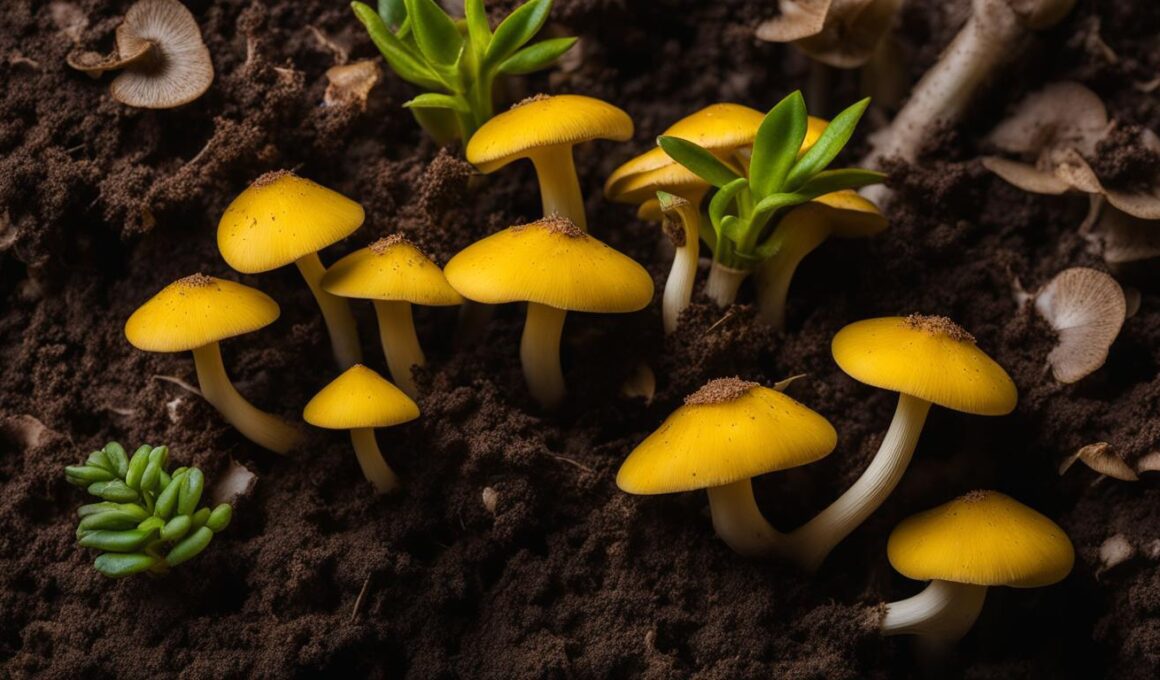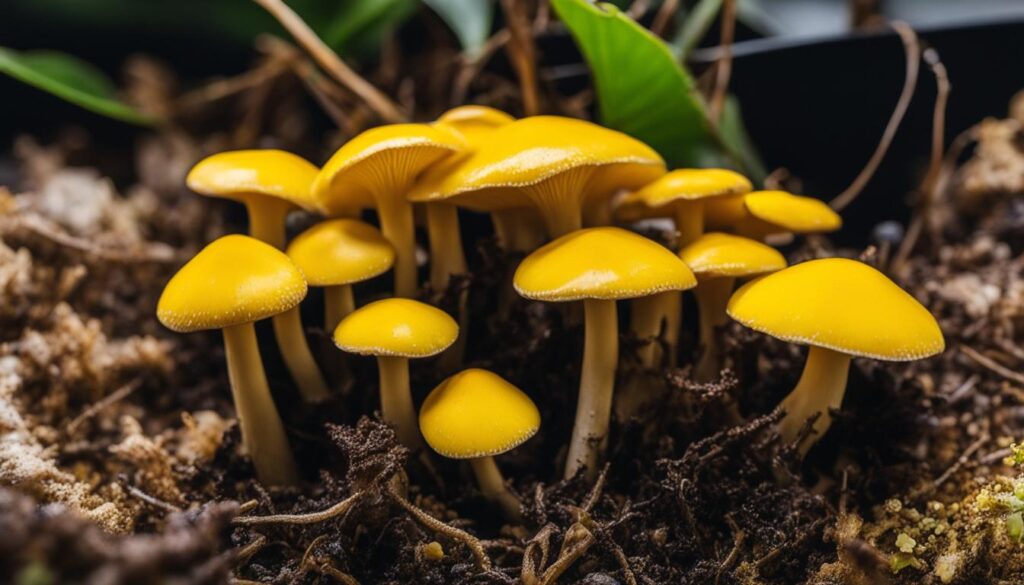Welcome to our article on yellow mushrooms in plants! If you own houseplants or have a greenhouse, you may have come across these vibrant fungi. Yellow mushrooms, specifically Leucocoprinus birnbaumii, are a common sight in potted plants and greenhouses. They play an important role in breaking down dead organic matter in the soil, which benefits the overall health of your plants.
These mushrooms have oval or bell-shaped caps and typically grow to about 1 to 3 inches tall. While they are harmless to your plants, it’s crucial to understand the potential risks they pose to you, your family, and your pets. Yellow mushrooms are considered poisonous to humans and animals, which is why it’s important to know how to handle them safely.
In this article, we will provide you with valuable care and safety tips for dealing with yellow mushrooms in your plants. Whether you’re curious about their presence or want to know how to remove them, we’ve got you covered. Let’s dive in!
Understanding Yellow Mushrooms in Houseplants
The most common species of yellow mushrooms found in houseplants is the Leucocoprinus birnbaumii. These vibrant fungi can grow up to 2 inches in diameter and are often seen either individually or in clusters. They thrive in warm and humid environments, making them a common presence in houseplants and greenhouses throughout the year. Despite their striking appearance, the presence of yellow mushrooms does not necessarily indicate overwatering of your plants.
Yellow mushrooms are typically introduced to houseplants through contaminated soilless mixes or are carried in by humans, pets, or airborne spores. While they do not pose a direct threat to the plants themselves, these mushrooms actually play a beneficial role in the health of your houseplant. They absorb ammonium, a nitrogen compound that can be harmful to plants in excess, and release essential nutrients back into the soil.
However, it’s important to note that yellow mushrooms can be dangerous to pets and humans if ingested. As a responsible plant owner, it is crucial to remove them from your houseplants, especially if you have pets or small children in your home.
The Role of Yellow Mushrooms in Houseplants
- Supports plant health by absorbing ammonium
- Provides essential nutrients to the soil
- Breaks down dead organic matter
Dealing with Yellow Mushrooms in Houseplants
If you decide to remove the yellow mushrooms from your houseplants, there are several steps you can take to address the issue.
First, it is important to remove the caps of the mushrooms to prevent the spores from spreading further. Simply pluck them off carefully.
If possible, consider changing the soil in your houseplant. Repotting the plant in fresh, uncontaminated soil or removing the top two inches of soil can help eliminate any remaining mushroom spores.
While fungicide treatments are generally not effective against mushrooms, there are some products available that may help manage the issue. Research and consult with professionals for suitable fungicide options.
Additionally, altering the conditions of your houseplant’s environment can help reduce the abundance of yellow mushrooms. Consider lowering the humidity levels, regulating the heat, and improving airflow around the plant. This can help create less favorable conditions for mushroom growth.
However, it’s important to note that these methods are not foolproof and may not completely eradicate the mushrooms. Some spores may still be present in the soil or roots. It is also important to consider the potential impact on the health of your plant when making changes to the conditions.
Conclusion
Yellow mushrooms in potted plants are generally harmless to your beloved houseplants. These little fungi play an important role by breaking down dead organic matter in the soil and providing essential nutrients to your green companions. However, it’s important to be cautious as they can be poisonous to both pets and humans. If you have little ones or furry friends around, it’s best to remove any yellow mushrooms that appear.
To manage the presence of yellow mushrooms, there are a few steps you can take. Firstly, promptly remove the mushrooms as soon as you spot them to prevent further spore dispersal. Secondly, consider changing the soil by repotting your plant in fresh, uncontaminated soil. This can help reduce the chances of the mushrooms reappearing. While fungicide treatments may not be effective against mushrooms, it’s still worth exploring different products as some may provide some control.
Additionally, altering the conditions of your potted plant can help decrease the abundance of yellow mushrooms. You can try reducing humidity levels, lowering the heat, and improving airflow around the plant. However, it’s important to note that these methods may not completely eradicate the mushrooms since they can be present in soil and roots. Remember, creating a healthy and thriving indoor garden requires regular care and attention to both your houseplants and the presence of yellow mushrooms.
Are Yellow Mushrooms and Orange Fungus Related and How Do I Care for Plants with Fungus?
Yellow mushrooms and orange fungus are both types of fungi that can affect plants, including trees. To care for plants with fungus, it’s important to identify the specific type of fungus and treat it accordingly. For orange tree fungus causes & treatment, consult a professional for effective solutions.










